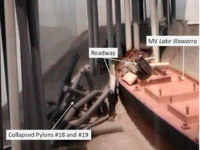
MV Lake Illawarra
Encyclopedia
The MV Lake Illawarra was a Handysize
Handysize
Although there is no official definition in terms of exact tonnages, Handysize most usually refers to a dry bulk vessel with deadweight of about 15,000–35,000 tons...
bulk carrier
Bulk carrier
A bulk carrier, bulk freighter, or bulker is a merchant ship specially designed to transport unpackaged bulk cargo, such as grains, coal, ore, and cement in its cargo holds. Since the first specialized bulk carrier was built in 1852, economic forces have fueled the development of these ships,...
of 7,274 tons in the service of the Australian National Line shipping company. This ship is known for causing the Tasman Bridge disaster
Tasman Bridge disaster
The Tasman Bridge disaster occurred on the evening of 5 January 1975, in Hobart, the capital city of Australia's island state of Tasmania, when a bulk ore carrier travelling up the Derwent River collided with several pylons of the Tasman Bridge, causing a large section of the bridge deck to...
when it collided with pylon 19 of Hobart
Hobart
Hobart is the state capital and most populous city of the Australian island state of Tasmania. Founded in 1804 as a penal colony,Hobart is Australia's second oldest capital city after Sydney. In 2009, the city had a greater area population of approximately 212,019. A resident of Hobart is known as...
's giant high concrete arch style Tasman Bridge
Tasman Bridge
The Tasman Bridge is a five-lane bridge crossing the Derwent River, near the CBD of Hobart, Tasmania. The bridge has a total length of 1,395 metres . It provides the main traffic route from the CBD to the eastern shore - particularly Hobart International Airport and Bellerive Oval...
on the evening of 5 January 1975 at 9.27pm., causing the deaths of 12 people.
The vessel
The Lake Illawarra was an ore carrier, and at the time of its collision was loaded with zinc concentrateZinc concentrate
Zinc concentrate is a semi-processed intermediate product used in the production of zinc metal and zinc alloys, which is the result of a flotation process after the zinc ore has been mined and milled...
, for the Electrolytic Zinc Company works at Risdon, about 3 nautical miles up the Derwent River
Derwent River (Tasmania)
The Derwent is a river in Tasmania, Australia. It was named after the River Derwent, Cumbria by British Commodore John Hayes who explored it in 1793. The name is Brythonic Celtic for "valley thick with oaks"....
from the bridge. This works later became Pasminco and is now the Zinifex
Zinifex
Zinifex was an Australian company which operated two zinc and lead mines, three zinc refineries and a lead smelter. It was created following the insolvency of Pasminco in 2002, taking on Pasminco operations. In 2008 it merged with Oxiana Limited to form OZ Minerals.-History:Zinifex was the...
Zinc
Zinc
Zinc , or spelter , is a metallic chemical element; it has the symbol Zn and atomic number 30. It is the first element in group 12 of the periodic table. Zinc is, in some respects, chemically similar to magnesium, because its ion is of similar size and its only common oxidation state is +2...
Refinery
Refinery
A refinery is a production facility composed of a group of chemical engineering unit processes and unit operations refining certain materials or converting raw material into products of value.-Types of refineries:Different types of refineries are as follows:...
.
The collision
Just before the impact, Captain Boleslaw Pelc realised as he passed Rosny PointRosny, Tasmania
Rosny is a suburb of the City of Clarence, part of the greater Hobart area, Tasmania, Australia. It is located on the eastern shore of the Derwent River, between the suburbs of Montagu Bay and Rosny Park, approximately 4 kilometres from Hobart's centre. Rosny is the residential part of its...
that he was off course, and travelling too fast. He tried to correct the heading, but only managed to bring the bows too far to port (left) and was now heading for the western shore. He urgently counter-corrected, but could not make the opening. Realising he was headed for a collision, he put the engines full astern, but the torque from her propeller caused the ship to slide in a broadside movement. She smashed into the 18th and 19th pylons.
Deaths and damage to the Tasman Bridge
The collision brought down the two support pylons and a 127 metre (417 ft) section of steel and concrete. There was evening traffic on the bridge, and although no vehicles were on the section that fell, four cars drove off the gap, with five people killed. Two cars stopped on the edge, their occupants able to escape. The section of four-lane highway landed on the ship's deck, sinking her in 35 metres (115 ft) of water to the south of the bridge. Seven of the ship's crew lost their lives in the accident.The wreck



